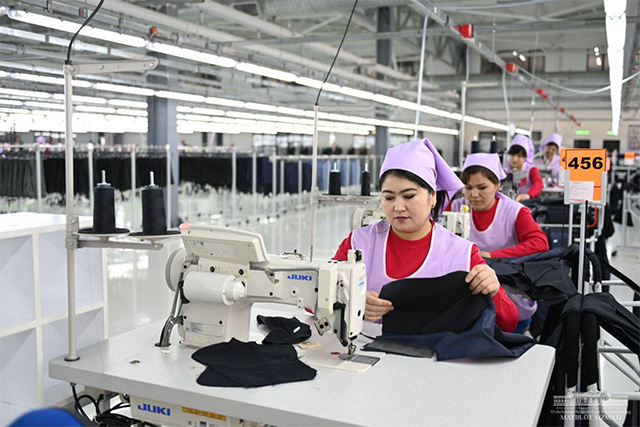
Uzbekistan’s Enterprises Produced Industrial Goods Worth 375 Trillion Soums
Uzbekistan’s Enterprises Produced Industrial Goods Worth 375 Trillion Soums
Tashkent, Uzbekistan (UzDaily.com) — In January–May 2025, industrial enterprises in Uzbekistan produced goods worth 375.0 trillion soums, with the physical volume index of industrial production reaching 106.4% compared to the same period in 2024. This was reported by the National Committee of Statistics.
As of 1 June 2025, there are 57,700 industrial enterprises operating in Uzbekistan.
By major types of economic activity, the largest share was recorded in food production — 11,700 enterprises (20.2% of the total), followed by other non-metallic mineral product manufacturing — 8,400 (14.5%), garment production — 5,800 (10.1%), fabricated metal products excluding machinery and equipment — 4,600 (8.0%), furniture — 4,000 (6.8%), textile products — 3,600 (6.2%), and rubber and plastic products — 2,700 (4.7%).
Per capita industrial output is significantly higher than the national average (9.9684 million soums) due to the concentration of large industrial enterprises in the Navoi region (63.7779 million soums), Tashkent city (22.4773 million soums), Tashkent region (18.1970 million soums), and Andijan region (10.7627 million soums).
Nationwide, industrial production per capita grew by 104.4%. The highest growth rates were observed in Jizzakh region (110.5%), Navoi region (109.0%), and Khorezm region (107.5%), all exceeding the national average.
In the first five months of 2025, manufacturing accounted for the largest share of industrial production — 316.8 trillion soums or 84.5% of the total. Mining and quarrying contributed 29.7 trillion soums (7.9%), electricity, gas, steam, and air conditioning supply — 26.4 trillion soums (7.0%), and water supply, sewerage, waste collection and disposal services — 2.1 trillion soums (0.6%).
During the reporting period, the country produced 488,200 tons of motor gasoline (a decrease of 14.3% compared to the same period in 2024), 249,300 tons of cotton yarn (down 4.2%), 441,800 tons of wheat flour from soft wheat and spelt (up 6.2%), 441,400 tons of diesel fuel (up 13.3%), 2,369,700 tons of coal (up 24.6%), 270,800 tons of oil (down 11.2%), 18.3703 billion cubic meters of natural gas (down 2.9%), and 7,126,600 tons of Portland cement (up 15.8%).
Within the manufacturing sector, food, beverage, and tobacco enterprises accounted for 17.7% of output (physical volume index: 108.8% compared to January–May 2024), textile, apparel, and leather goods — 16.6% (108.5%), machinery and equipment production, vehicle and trailer manufacturing, and fabricated metal products — 18.6% (106.6%), while chemical products and rubber and plastic goods made up 6.8% (99.4%).
In terms of technological complexity within manufacturing, high-tech industries comprised 1.0% (1.2% in January–May 2024), medium-high-tech industries — 20.0% (down from 23.6%), medium-low-tech — 40.3% (up from 38.9%), and low-tech industries — 38.6% (up from 36.3%).
In the automotive sector, production figures from January–May 2025 were as follows: 58,904 Cobalt vehicles (up 2.4% year-on-year), 3,362 Chery (down 15.9%), 10,076 KIA (up 35.6%), 38,753 Damas (up 24.1%), 17,397 specialized passenger cars (up 74.0%), 18,079 Tracker (down 6.2%), 16,215 Onix (up 8.8%), 2,930 Haval (a 12.7-fold increase), and 5,495 BYD units.
Compared to the same period in 2024, electricity production from January–May 2025 stood at 104.2%, while heat production by large enterprises dropped to 88.9%.
There was also a 37.4% increase in the production of textile waste, an 8.0% rise in wastewater removal, transportation, and treatment services, and a 3.1% increase in services related to the emptying, cleaning, and treatment of septic tanks, cesspools, and sumps.